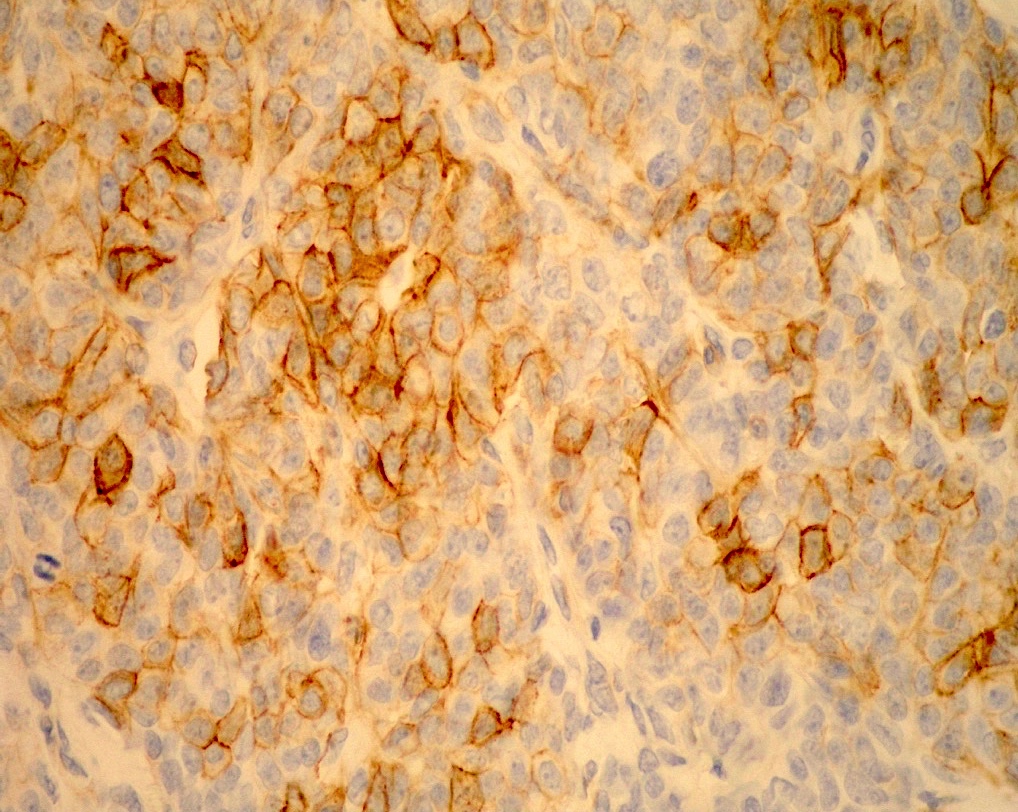Table of Contents
Definition / general | Essential features | Pathophysiology | Clinical features | Interpretation | Uses by pathologists | Prognostic factors | Microscopic (histologic) description | Microscopic (histologic) images | Positive staining - normal | Positive staining - disease | Negative staining | Board review style question #1 | Board review style answer #1Cite this page: Terlević R, Vranić S. SSTR2A. PathologyOutlines.com website. https://www.pathologyoutlines.com/topic/stainsSSTR2A.html. Accessed March 31st, 2025.
Definition / general
- Somatostatin receptor 2a
- 1 of 5 types of somatostatin receptors
Essential features
- Widest expression among somatostatin receptors
- Expressed in a variety of neuroendocrine and other tumors
- Also expressed in normal tissues (brain, pituitary, pancreatic islet, stomach foveolar cells, duodenal glands, small and large intestine surface epithelial cells, kidney, testis, endothelium, lymphocytes, monocytes, macrophages and fibroblasts) (Exp Clin Endocrinol Diabetes 2012;120:482, Endocr J 2005;52:605)
- Expression in solid tumors is associated with improved clinical outcome (Pancreas 2016;45:1386, Eur J Nucl Med Mol Imaging 2017;44:468, Medicine (Baltimore) 2015;94:e1281)
Pathophysiology
- Transmembrane G protein coupled receptor, widely distributed in normal human tissues
- Mediates antisecretory effects of somatostatin by inhibiting high voltage activated calcium channels (FEBS Lett 1994;355:117)
- Mediates antiproliferative effect in tumors via direct and indirect mechanisms
- Direct mechanisms include promotion of apoptosis via upregulation of Bax, inhibition of growth factor action on tumor cells via inhibition of MAPK phosphorylation and cell cycle arrest (Front Neuroendocrinol 2013;34:228)
- Indirect mechanisms include inhibition of growth factor secretion and antiangiogenic effects via upregulation of potent angiogenic inhibitor thrombospondin 1 in pancreatic tumors, inhibition of secretion of VEGF, PDGF, IGF1 by endothelium and monocytes (Proc Natl Acad Sci U S A 2009;106:17769, Mol Endocrinol 2005;19:255)
- SSTR2 expression in nasopharyngeal cancer is induced by the Epstein-Barr virus (EBV) latent membrane protein 1 (LMP1) via the NFκB pathway (Nat Commun 2021;12:117)
Clinical features
- Mediates the antisecretory effect of somatostatin analogues in growth hormone secreting pituitary adenomas and hormone secreting neuroendocrine tumors of the gastrointestinal tract (Front Neuroendocrinol 2013;34:228)
- Imaging and potential therapeutic target in neuroendocrine neoplasms, olfactory neuroblastoma and small cell lung cancer (Nat Commun 2021;12:117, Clin Imaging 2019;56:146, Head Neck Pathol 2021;15:1185, Mol Cancer Ther 2019;18:1926)
Interpretation
- Membranous and cytoplasmic staining
Uses by pathologists
- Differentiates follicular dendritic cell sarcoma (positive) from inflammatory pseudotumor-like follicular dendritic cell sarcoma (negative) (Am J Surg Pathol 2019;43:374)
- Differentiates olfactory neuroblastoma (positive in 75%) from sinonasal carcinoma (negative) and other mimickers (Hum Pathol 2018;79:144, Head Neck Pathol 2021;15:1185)
- As part of a panel to differentiate between gastrointestinal and pulmonary neuroendocrine carcinoma (Virchows Arch 2021;479:481)
Prognostic factors
- Independent predictor of improved overall survival and progression free survival in neuroendocrine tumors (NET) (Pancreas 2016;45:1386, Eur J Nucl Med Mol Imaging 2017;44:468, Medicine (Baltimore) 2015;94:e1281)
- Cytoplasmic expression correlates with increased disease free survival in neuroendocrine breast carcinoma (Oncology 2019;96:147)
- Expression is correlated with better overall survival in anaplastic oligodendroglioma, IDH mutant and 1p / 19q codeleted (Acta Neuropathol Commun 2018;6:89, Oncotarget 2017;8:49123)
- Expression in medullary thyroid carcinoma correlates with improved survival, especially in stage IV (Endocrine 2018;62:639)
- Improved recurrence free survival in gastrointestinal stromal tumor (Am J Transl Res 2014;6:831)
- Associated with worse prognosis in hepatocellular carcinoma (Histopathology 2017;70:492, Pathol Int 2021;71:682)
- Independent prognostic factor in meningioma (Neurosurg Rev 2022;45:2671)
Microscopic (histologic) description
- Staining intensity usually variable
Positive staining - normal
- Brain, anterior pituitary, pancreatic islets, adrenal cortex (Exp Clin Endocrinol Diabetes 2012;120:482)
- Stomach and duodenum enterochromaffin cells, small and large intestine surface epithelial cells (Exp Clin Endocrinol Diabetes 2012;120:482)
- Kidney: glomerulus (Exp Clin Endocrinol Diabetes 2012;120:482)
- Testis: tubules (Exp Clin Endocrinol Diabetes 2012;120:482)
- Endothelium, lymphocytes, monocytes, macrophages and fibroblasts (Exp Clin Endocrinol Diabetes 2012;120:482)
- Follicular dendritic cells (J Cancer Res Clin Oncol 2018;144:1921)
Positive staining - disease
- Neuroendocrine tumors, particularly small intestine (90%) and pancreas (76 - 80%) (Pancreas 2016;45:1386, Medicine (Baltimore) 2015;94:e1281)
- Neuroendocrine breast cancer (71%) (Ann Diagn Pathol 2019;38:62)
- Pituitary adenoma, particularly growth hormone secreting (65%) (Pathology 2018;50:472)
- Gastrointestinal stromal tumor (87.6%) (Am J Transl Res 2014;6:831)
- Olfactory neuroblastoma (75 - 99%), including metastases (Head Neck Pathol 2021;15:1185, Hum Pathol 2018;79:144)
- Paraganglioma (88%) (including metastases) and pheochromocytoma (73%) (Hum Pathol 2019;86:66)
- Small cell lung cancer (50%, 15 cases) (J Cancer Res Clin Oncol 2018;144:1921)
- Follicular dendritic cell sarcoma (100%) (Am J Surg Pathol 2019;43:374)
- Lymphoepithelioma-like carcinoma with squamous differentiation (J Clin Pathol 2021;74:704)
- Nasopharyngeal Epstein-Barr virus associated carcinoma (Hum Pathol 2021;117:88)
Negative staining
- Inflammatory pseudotumor-like follicular dendritic cell sarcoma (Hum Pathol 2018;79:144)
- Sinonasal carcinoma (Hum Pathol 2018;79:144)
- Olfactory neuroblastoma mimickers (Head Neck Pathol 2021;15:1185)
- Lymphoepithelioma-like carcinoma with glandular differentiation (J Clin Pathol 2021;74:704)
Board review style question #1
Which of the following tumors is most likely to stain with SSTR2A?
- Grade I neuroendocrine tumor of the small intestine
- Grade II neuroendocrine tumor of the pancreas
- Neuroendocrine breast cancer
- Oligodendroglioma
- Small cell lung cancer
Board review style answer #1




